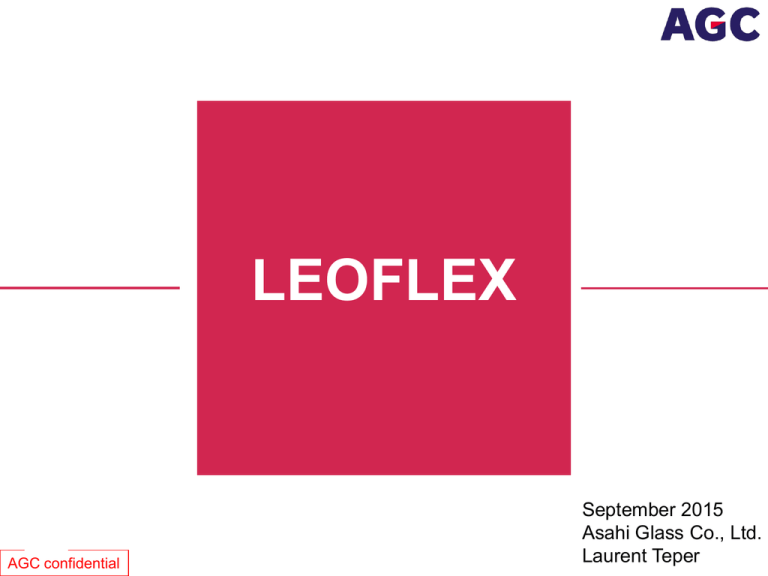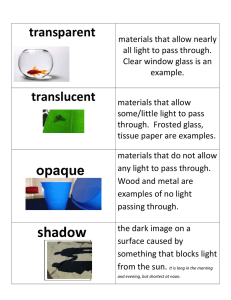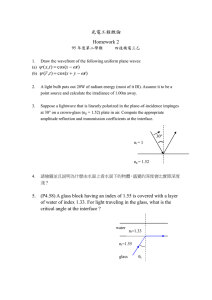
LEOFLEX
AGC confidential
September 2015
Asahi Glass Co., Ltd.
Laurent Teper
Business Overview
AGC Group (Turnover: € 10.3B ; Employees: 51,000)
Glass
Electronics
Chemicals
Other
46%
32%
20%
2%
Flat Glass
-Float flat glass
-Figured glass, Polished wired glass
-Low-E glass
-Fabricated glass for architectural use
(Heat Insulating/shielding glass,
Safety glass, Fire-resistant glass,
Security glass)
-Glass for solar power system
-Fabricated glass for industrial use
-Decorative glass, etc.
Display
-Glass substrate for display devices
-Specialty glass for display applications
-Display related materials
Fluorochemicals
& specialty chemicals
-Fluorinated resins
-Water and oil repellents
-Pharmaceutical and agrochemical
intermediates
-Iodine-related materials
-Battery materials
Electronic Materials
Automotive Glass
-Tempered glass
-Laminated glass
2
AGC confidential
-Optical membranes
-Optoelectronics materials
-Synthetic quartz glass
-Glass frit and paste
-Materials for semiconductor
manufacturing equipment
-Lighting glass products, etc.
Chlor-alkali & urethane
-Raw materials for vinyl chloride
polymer
-Caustic soda
-Urethane
-Gases
-Solvents, etc.
-Ceramic products
-Logistics and financial
services, etc.
Global Operations
The Americas
Sales: 6%
Employees:3,700
-Flat Glass
-Automotive Glass
-Electronic Materials
-Chemicals
Europe
Sales:20%
Employees:14,200
-Flat Glass
-Automotive Glass
-Chemicals
Japan & Asia
Sales:74%
Employees:33,100
-Flat Glass
-Automotive Glass
-Display Glass
-Electronic Materials
-Chemicals
-Ceramics
Leoflex was released in Japan in 2011 and in Europe & US in 2014.
AGC confidential
BASIC
INFORMATION
AGC confidential
AGC GROUP - 4
Leoflex Alumino-Silicate Glass
AGC confidential
All Rights Reserved, Copyright (c) Asahi Glass Co.,Ltd.
Key Properties
• Alumino-silicate glass
• Thicknesses:
– 0.55 to 1.3 mmt
• Can be chemically strengthened (CS)
– DOL 15 – 40 um
– Compressive Stress – 550 to 850 MPa +
• Large sheet size
– Up to 2070mm X 1650mm
• Bendable after chemical strengthening
– Between 100mm and 300mm bending radius
AGC confidential
Chemical Tempering
The chemical tempering method was developed in early 1960’s.
Glass is immersed in molten salt at a temperature below strain point of glass.
Ion exchange, smaller Na+ by larger K+, in the surface of glass leads to
compressive stress in the glass surface. This compressive stress layer makes glass tougher.
Glass
molten KNO3
K+
K+
K+
K+
K+
r=1.33 A
Si-O
Glass
backbone
moltenKNO
KNO3
molten
3
compressive stress
K+
K+
Na+
r=0.95A
GlassGlass
surface
compressive
K+
K+
K+
K+
K+
K+
K+
K+
K+
K+
K+
K+
K+
K+
K+
K+
K+
K+
K+
K+
K+
K+
K+
Ion Exchange between Na+(●) and K+(●)
AGC confidential
K+
K+
K+
K+
K+
K+
K+
K+
K+
K+
K+
K+
K+
K+
K+
K+
After Ion exchange, the compressive stress
layer is formed in the glass surface.
Chemical vs Thermal Tempering
(Thermal tempering : Conventional technique for PV module glass)
Thermally
tempered
(Chemically tempered)
Minimum thickness
limit
3.2 mmt
0.55mmt
Light weight
Mechanical strength
(Compressive
Marginal stress)
80 MPa
260 MPa
Resistance to bending
Ion concentration at
glass surface
Leoflex
Na+
rich
(Na2O >10 wt.%)
<Image of thermally tempered glass>
Heating up
AGC confidential
Rapid cooling down
less Na+
(Na2O < 3 wt.%)
K+ rich
Leoflex features
Chemically stable
** Values are not guaranteed.
Rapid cooling glass after heating up
beyond its softening point creates
compressive stress at glass surface.
There is no ion exchange at glass
surface.
Properties comparison (Summary)
Leoflex
(0.85mm)
Thermally tempered
(3.2mm)
Strength / Marginal stress 短期許容応力 (MPa)
260
80
Young modulus ヤング率 (GPa)
74
70
Poisson ratio ポアッソン比
0.23
0.2
Density 密度 (g/cm3)
2.48
2.5
Vickers Hardness
673
527
91.6
91.1
Expansion coefficient 線膨脹係数 (10-6 1/K)
9.8
9
Strain point 歪点 (℃)
556
500
MECHANICAL CHARACTERISTICS
ビッカース硬度
OPTICAL CHARACTERISTICS
Energy Transmission 日射透過率 (%)
THERMAL CHARACTERISTICS
** Values are not guaranteed.
AGC confidential
Transmittance (Leoflex 0.85t, Solite 3.2t)
Leoflex / SOLITE Transmittance (no coating)
** Due to embossed surface of SOLITE, both SOLITE and Leoflex surface are specially treated.
100
Transmittance [%]
95
90
85
Leoflex
solite
80
75
70
300
400
500
600
700
800
Wavelength [nm]
900
1000
1100
** Values are not guaranteed.
Leoflex shows the same transmittance as SOLITE.
AGC confidential
1200
Surface Compressive Stress Strength
Breaking stress are compared by Ring on Ring measurement method
RoR Stress Strength Test Result
0.99
Crack Probability
0.90
0.5
0
0.05
Thermally tempered 3.2t
0.01
LeoflexTM 0.85t
** Values are not guaranteed.
100
Stress(MPa)
1000
Thinner LeoflexTM is stronger and more stable against stress
compared to thermally tempered glass.
Appropriate module design is required because Leoflex is flexible.
AGC confidential
Scratch Resistance
Scratch mark is made by scratching intensity tester HEIDON.
Specimen
400gf
650gf
Leoflex
Soda-lime
(thermally tempered)
** Values are not guaranteed.
AGC confidential
Chemical Stability against Weathering
Leoflex seldom whitened after accelerated weathering test.
Sodalime glass
Leoflex glass
3
Leoflex
Haze[%]
2.5
Sodalime
2
1.5
1
0.5
0
0
50
100
150
200
Time[hour]
** Values are not guaranteed.
AGC confidential
Leoflex Features
•
Lightweight
•
Chemically stable
•
Impact resistant
•
Weather resistant
•
Scratch resistant
•
Optically Clear
•
Flexible
- Million of m2 already sold for electronics, solar, building & industrial
- Glass currently produced and processed in Asia
- Working on having local supply chain in US and EU (2016-17)
AGC confidential
Processing
• Laminating (PVB, EVA, etc.)
after tempering
• Cutting
before / after tempering
• Grinding
before / after tempering
• Drilling
before / after tempering
• Painting, Printing, Silvering
after tempering
• Coating
after tempering
• Cold Bending
after tempering
AGC confidential
POTENTIAL
APPLICATIONS
AGC confidential
AGC GROUP - 16
Potential Applications: Architecture (1/2)
AGC confidential
Potential Applications: Architecture (2/2)
AGC confidential
Potential Applications: Solar
AGC confidential
Potential Applications: Industrial
AGC confidential
Towards Lighter & Stronger Buildings
Product
Glass Thickness
(mmt)
Product Weight
(kg)
Weight Gain
Solar Module
3.2 > 0.85
17.0 > 9.5
-44%
Platform Screen Door
4.0 > 1.3
50.0 > 30.0
-40%
Potential Benefits
- Easier installation and maintenance
- Potential savings on material and construction (i.e. less material used)
- Creation of new hybrid materials (e.g. glass/metal, glass/plastic)
- Advantage of glass aesthetics & durability for weight of plastic
Commercial Applications & Current Development Projects
Insulated Glazing Units (IGU) • Interior Decorative Glass • Architectural
Cold Bent Glass • Automotive Interior & Exterior • Laminated Safety
Glass • Solar cover glass (PV, BIPV) • Train windows & Windshields • etc.
AGC confidential
THANK YOU !
WE WOULD LOVE TO HEAR ABOUT
YOUR IDEAS & PROJECTS !
LAURENT-TEPER@AGC.COM
AGC confidential
AGC GLASS EUROPE - 22


